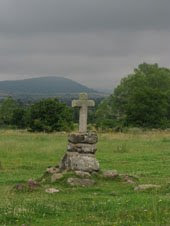 Heading south then east from London, we left the centre of tourist attractions and royal parks and were soon among the rows of terraced houses put up to shelter the workers of the industrial revolution and the Victorian expansion. Mile after mile London stretched, barely remembering that it used to be villages. When did Streatham last have a Vale to boast of?
Heading south then east from London, we left the centre of tourist attractions and royal parks and were soon among the rows of terraced houses put up to shelter the workers of the industrial revolution and the Victorian expansion. Mile after mile London stretched, barely remembering that it used to be villages. When did Streatham last have a Vale to boast of?Beneath all these bricks was London clay, but by the time we reached true grass and woodland, on the second day of walking, we were on chalk downs. It used to be countryside; is now more country park, as yet reserved and kitted out for our recreation. Gardeners in these parts have learned to work with chalk-loving plants, and the flints they dig out of the soil have for centuries bulked out the walls of their houses and churches.
As the North Downs ridge headed east, the soil was dark brown and thick where years of leaves had mulched it, but pale and sickly clinging to our boots in the open fields. Then the chalk faded into sandstone hills and the tracks were cut deeper between their soft banks, clean and soft to walk on.
We said goodbye to the ridge of hills and hello to the river landscapes of the Wey and the Itchen. Clear and leaping over sandy bottoms, the rivers nurtured watercress, which though commercially productive in places and at times in history, to us merely lent a vivid green detail like a Pre-Raphaelite painting.
Here and there the rain had made the rivers swell and rise; pouring through weaknesses in the banks to flood the path, and here again we cursed the dark clinging mud that was more than one-part cow shit.
 The coast of the Solent from Bitterne Park to Portsmouth is industrial and drab. Even in high summer I doubt it would look anything other than a smudgy brown. The beach is pure pebble and shell, loud to walk along and bruising to the feet. It’s not a place for summer holidays and sandcastles, even before you glance out at the waterway full of cargo ships, naval vessels and pleasure boats, each discharging their share of oil residue.
The coast of the Solent from Bitterne Park to Portsmouth is industrial and drab. Even in high summer I doubt it would look anything other than a smudgy brown. The beach is pure pebble and shell, loud to walk along and bruising to the feet. It’s not a place for summer holidays and sandcastles, even before you glance out at the waterway full of cargo ships, naval vessels and pleasure boats, each discharging their share of oil residue.Whereas Portsmouth looks out to sea beyond the Isle of Wight, half-hiding coyly behind the curve of its old harbour and the marina of Gosport across the bay, Caen is buried deep inland, 15 or so miles down the joint channels of the Orne River and the Canal de Caen. This southern shore of the English Channel has wide, finely-sanded beaches stretching flat and insubstantial for miles down the coast. The sea falls far away at low tide leaving firm wet sands shimmering into the water and the sky – good for horse riding as well as shell-combing. This is the country of the D-Day landings. Not until nearly Deauville, heading west from Caen, do hills rise behind the coast: wooded folds and valleys whose soil echoes the flints and chalk of the English Downs.
 And finally we look down the steep slopes above attractive Honfleur to the mouth of the Seine, the wide mud and salt-marsh estuary of one of France’s great rivers with its tiara of the Pont de Normandie suspension bridge over to Le Havre.
And finally we look down the steep slopes above attractive Honfleur to the mouth of the Seine, the wide mud and salt-marsh estuary of one of France’s great rivers with its tiara of the Pont de Normandie suspension bridge over to Le Havre.




































































No comments:
Post a Comment